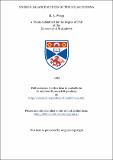Energy-balance models of the solar corona
Abstract
Solar coronal observations have shown that the corona has a highly complex structure which presumably owes its existence to the magnetic field. Models in thermal and hydrostatic equilibrium are here calculated in order to try and explain many of these observations. Coronal holes occur where open field lines reach out into space. The model of McWhirter, et al. (1975) for the inner corona in such a configuration is generalised to allow different types and magnitudes of heating as well as different area divergences and flows. It is found that hot, fast upflows cannot always exist in thermal equilibrium. The choice of boundary conditions can appreciably alter the results, and so different choices are compared. Most of the corona, especially in active regions, appears to consist of coronal loops. Subtle relations for energy balance models of such loops are found to exist between the physical parameters of a loop's length, base density, and heat input. No solution exists at coronal temperatures in certain cases, which may explain the observations of very cool loops. The effect of a loop's geometry and field line divergence on the structure is found. Results predicted from scaling laws are compared, and the uniqueness of the solution for a loop with a fixed mass is studied. The error in the predicted emission measure through assuming uniform pressure is shown to be considerable. The life-time of a loop can often be many days, suggesting the existence of a thermally stable state. A global stability analysis is performed, and it is found that a loop's stability may depend critically upon its length. Thermally isolated loops, which are the most unstable type, can be thermally stable, provided their pressure falls off sufficiently rapidly with height (due to hydrostatic equilibrium).
Type
Thesis, PhD Doctor of Philosophy
Collections
Items in the St Andrews Research Repository are protected by copyright, with all rights reserved, unless otherwise indicated.

